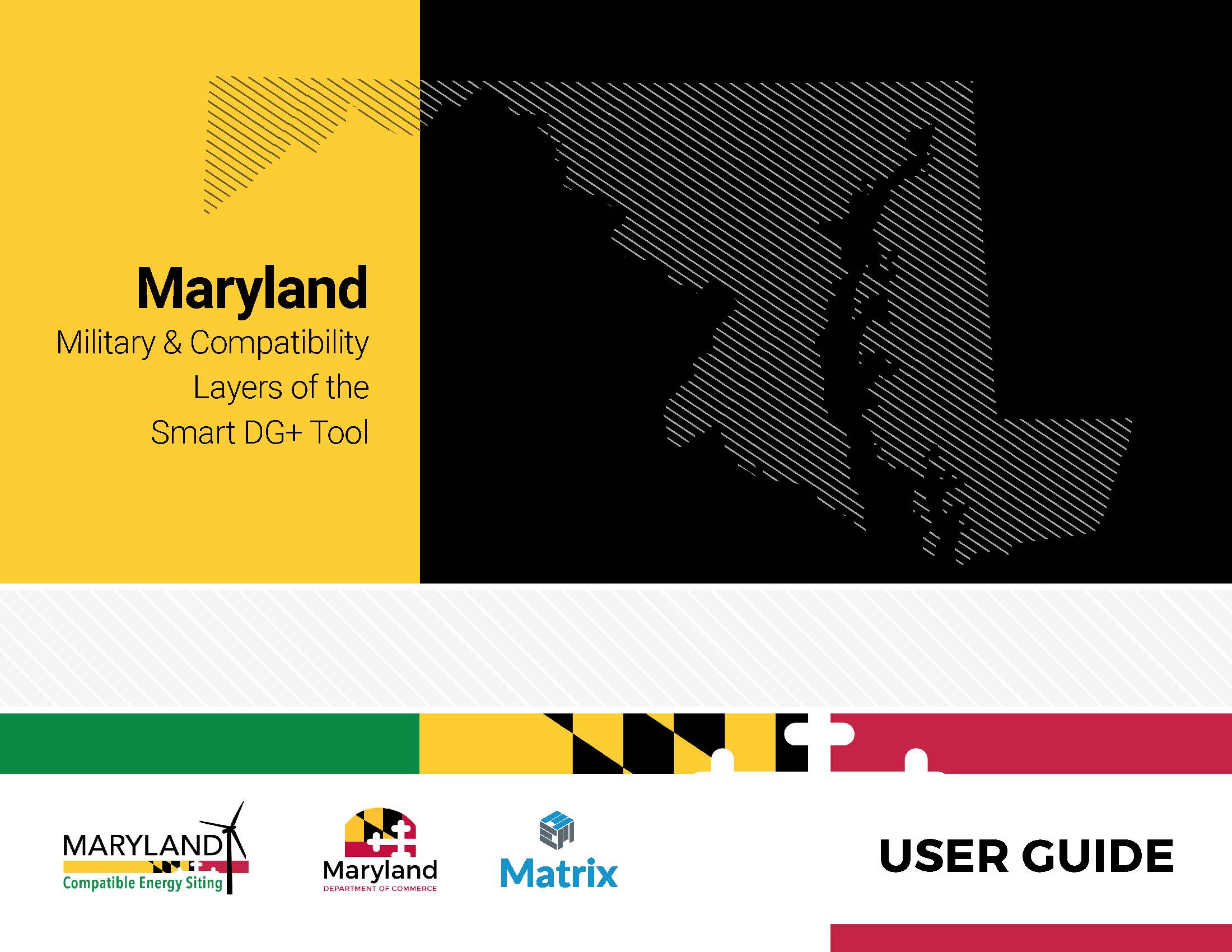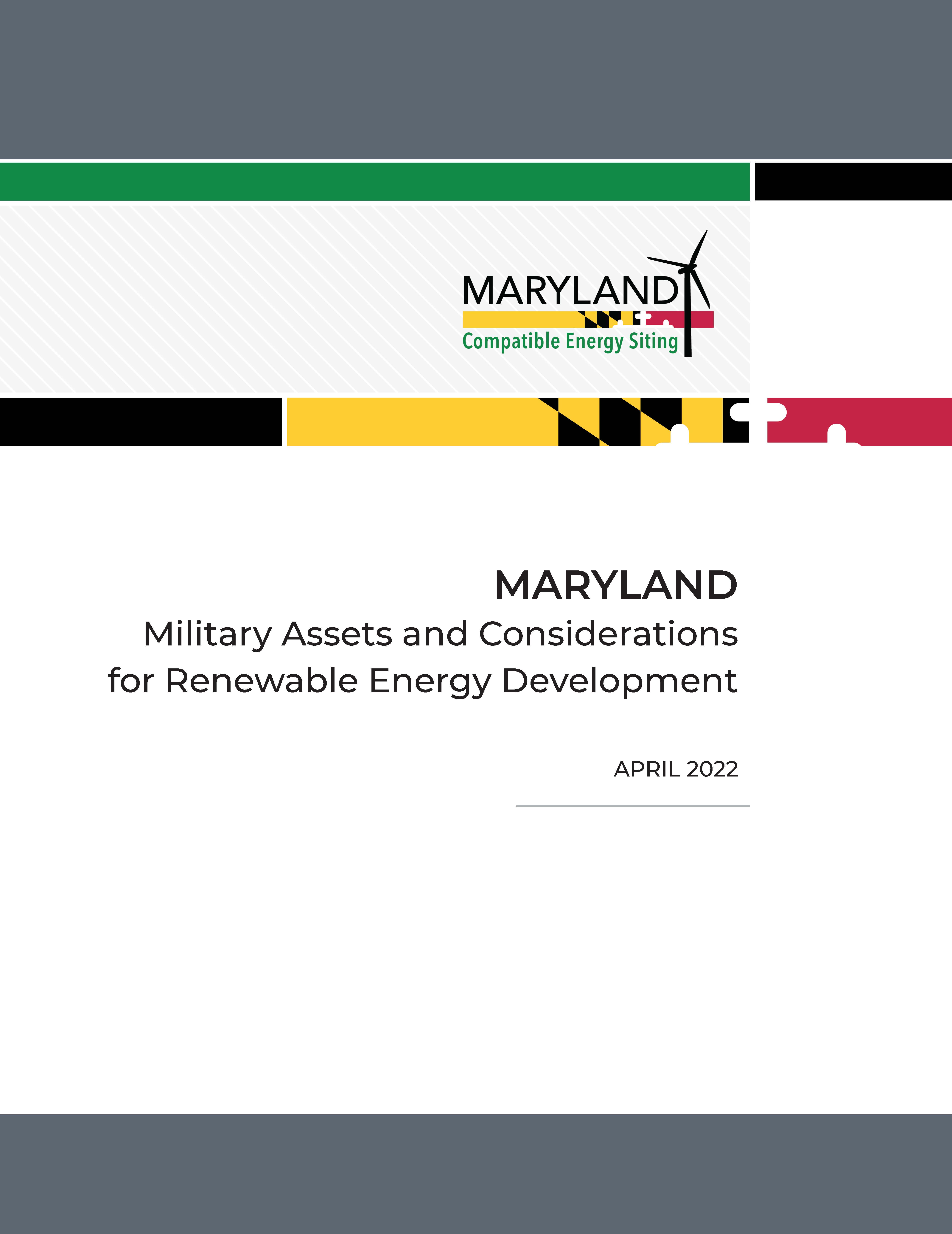The Military and Compatibility Layers of the Maryland Smart DG+ ToolThe Military and Compatibility Layers of the Smart DG+ Tool provide military and other federal, state, and local stakeholders with information to help develop renewable energy projects within the State of Maryland. |
The Military and Compatibility Layers of the Smart DG+ Tool are designed to provide information to assist with the early coordination for siting renewable energy development projects between energy developers; local, regional, state, and federal stakeholders; and military installations within the state. Early coordination can benefit renewable energy projects by identifying potential issues and mitigation opportunities across all stakeholder groups that can improve efficiency in project approvals, ultimately saving time and cost.
The Military and Compatibility Layers of the Smart DG+ Tool provide information to help inform the project planning process and combine an array of geographic map layers along with other pertinent data and corresponding contact information:
- Military installations and areas where military operations are conducted across the state
- Existing structures within Maryland airspace including wind turbines, communication towers, transmission lines, and radars
- Areas of energy development opportunity, including solar potential and wind potential
- Land ownership, including Jurisdiction boundaries, Maryland Department of Natural Resources lands, State protected lands, U.S. Fish & Wildlife Service protected lands, and National Park Service assets
- Environmental & Cultural Resource areas
The Military and Compatibility Layers contained in the Maryland Smart DG+ tool provide preliminary information and coordination points of contact only. Military areas depicted are for informational purposes only, and do NOT constitute automatic exclusion areas for renewable energy development projects. Use of the tool does not replace other coordination, planning, and review requirements at the local, state, and federal levels, and is not intended for project specific analysis. Use of the military and compatibility data in SmartDG+ does not constitute an informal or formal review by the Department of Defense (DoD) per Title 32 Code of Federal Regulations (CFR) Part 211, Mission Compatibility Evaluation Process or review through the Maryland Certificate of Public Convenience and Necessity (CPCN) process per Sections 7-207 and 7-208 of the Maryland Code.
What You Can Do with the Military and Compatibility Layers of the Maryland Smart DG+ Tool
Control What You Want to See
Turn layers on or off in the Data Layer window to view what is relevant to you.
Select Military & Compatibility Layers
Activate a table of contents for military and compatibility layers after confirming your understanding of the limitations on the disclaimer splash screen.
Identify Areas of Interest
Create custom Areas of Interest by drawing a shape or uploading a file to get an output display of features that intersect those areas and associated contact information.
Create Coordination Reports
Create and save Coordination Reports in Adobe PDF, Microsoft Excel workbook, or HTML formats. The Coordination Report is a summary of relevant information to facilitate early communication with potential stakeholders when considering energy development within a user-defined area. The Coordination Report displays a map view of the area along with individual features that intersect the defined area including all points of contact associated with each feature.
How were the Military and Compatibility Layers of the Maryland Smart DG+ Tool developed?
The Military and Compatibility Layers of the Smart DG+ Tool were funded by the Department of Defense (DOD) Office of Local Defense Community Cooperation (OLDCC) under the management of the Maryland Department of Commerce, Office of Military & Federal Affairs, with the assistance of the Department of Natural Resources, Power Plant Research Program. Representatives from local governments, state departments, the renewable energy industry, and military installations in Maryland participated in the development of the Military and Compatibility Layers of the Maryland Smart DG+ Tool.
Software Requirements
The Print to PDF function has been tested using Adobe Acrobat Reader release 20.004.30020.
The Excel button has been tested using Microsoft Office 365.


Maryland MilitarY Compatibility Report
The Maryland Military Assets and Considerations for Renewable Energy Development report, also known as the Maryland Military Compatibility report, describes the military installations and military operational areas throughout the state including Military Training Routes, Special Use Airspace, other types of military airspace, and military radars. The report discusses renewable energy development and transmission lines in Maryland and their potential impacts on military missions. The report concludes with a section on the importance of coordination and opportunities for early mitigation. Additional appendices include best practice recommendations to enhance existing state renewable energy siting processes, case study examples of how the Maryland Military and Compatibility Layers of the SmartDG+ Tool can be integrated into local government planning processes, and model ordinance language for local government renewable energy siting.